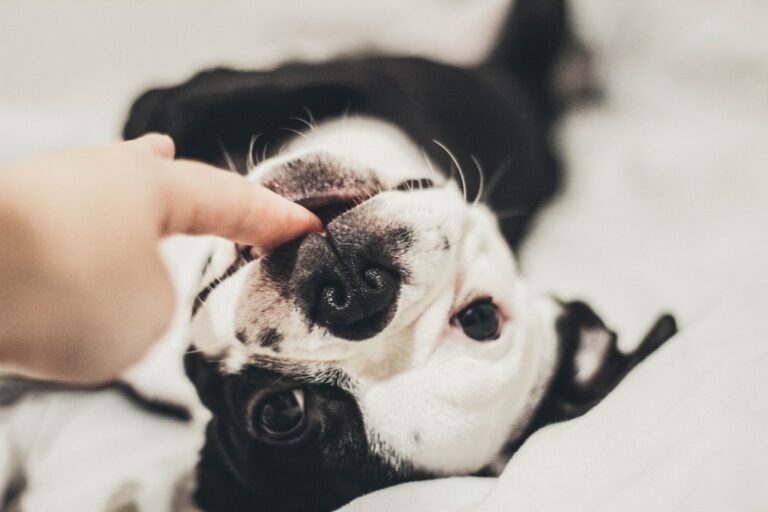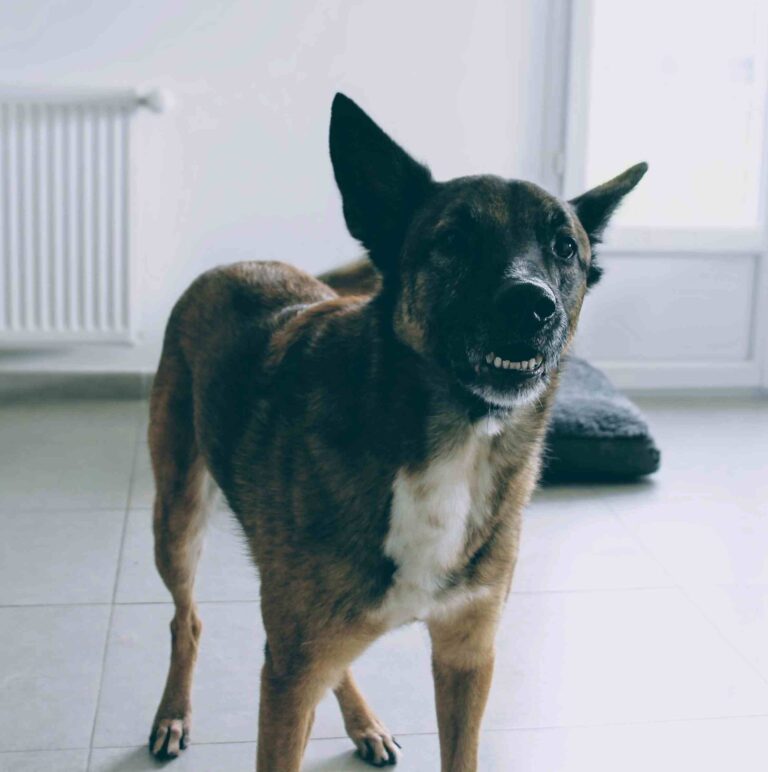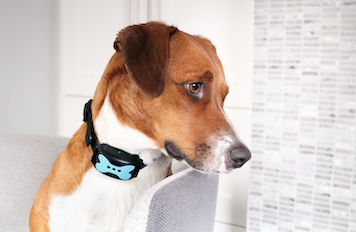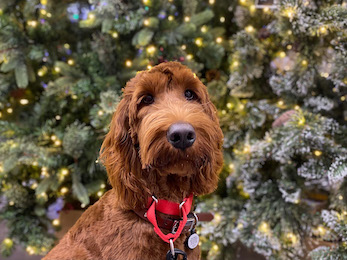As a Certified Applied Animal Behaviorist and Board Certified Behavior Analyst, positive reinforcement is an everyday process I use when working with trainers, owners, and puppies. Most trainers or owners consider the use of positive reinforcement and rely on it in the context of teaching new obedience behaviors. Typical behaviors include teaching sit, down, or come when called. However, many need to consider using positive reinforcement to reduce problem behaviors. One of my favorite puppy problem behaviors to target using positive reinforcement, and the first of this series, is play biting. Those puppy teeth are so sharp, you may feel as though you have just adopted a little land alligator!
Supplies
To start, you’ll need a 4-6 ft leash (one made of cable or chain if you have an extreme chewer) and 10-15 appropriate toys. The leash will help you manage your puppy and their environment. I usually recommend that young puppies be tethered to something stationary or, at a minimum, drag a leash. This will help prevent play biting from unintentionally being reinforced and allow you to teach an appropriate behavior using positive reinforcement. Appropriate toys include Kongs, Nylabones, shin bones, or deer antlers. Any hard, rubber food-dispensing toys work great too. Avoid toys that resemble clothing, shoes, or household items—no fabric, leather, plush, or rope toys.
Positive reinforcement training in action
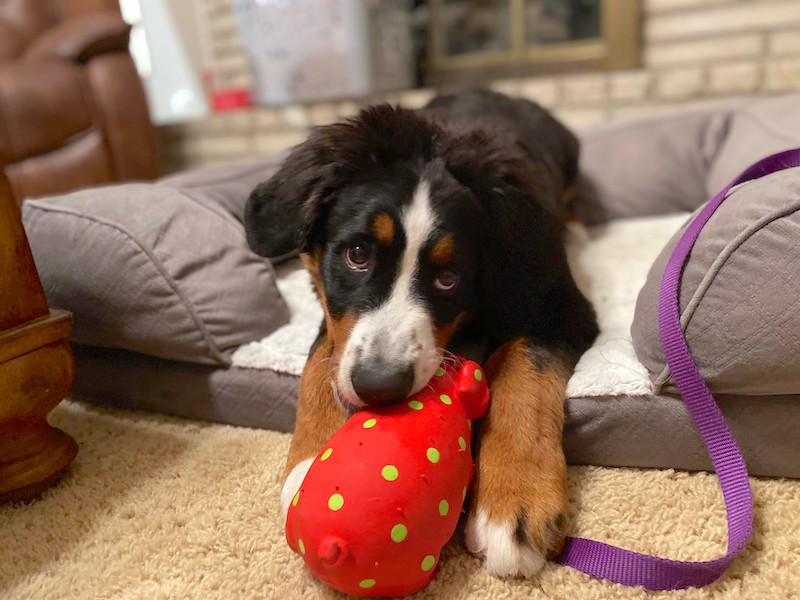
The Play-biting Exercise
Once you have your supplies, put your puppy on a leash and tether them to a stationary piece of furniture. The furniture needs to be heavy and secure, so your puppy does not pull it over and onto them. Once you have them tethered, offer your puppy the toys and sit just out of reach. Hold a toy in your hand and offer it to your puppy. Watch for your puppy’s mouth to go onto a toy. The moment their teeth touch a toy, begin calmly praising and petting. Observe your puppy’s mouth. If their teeth come off the toy, stop petting and praising. If their teeth go back on the toy, begin petting and praising again. If your puppy’s teeth touch you at any point, get up and walk away. Continue this active training process, about 30 minutes per day, allowing your puppy to select the toy they prefer. You can use your puppy’s preferences to guide your toy purchasing in the future! Kids can get involved in toy play as well.
How to manage play-biting behavior
Outside of the training exercises, continue capitalizing on one of my top 3 puppy training tips by having your puppy tethered (or confined), so you can manage your puppy’s behavior. This helps prevent them from engaging in problem behaviors. While tethered or confined, your puppy should have access to 10-15 appropriate toys.
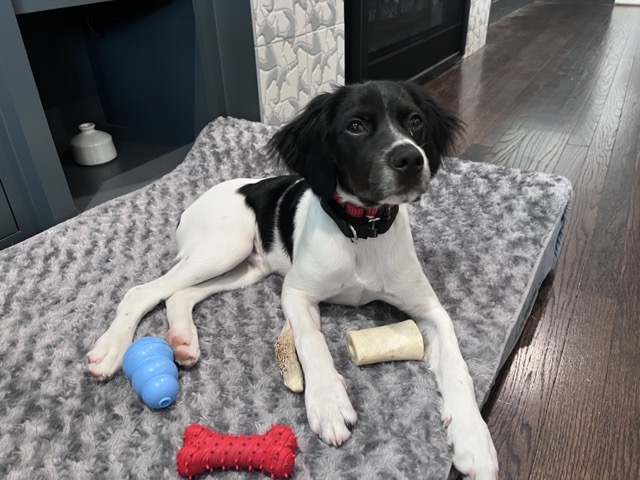
Utilizing your puppy’s meal to encourage appropriate chewing
In addition to actively teaching and managing your puppy’s behavior, you can passively teach your puppy to chew on toys. Forgo your puppy’s food bowl and use their toys to dispense the food instead. The dog food will initially come pouring out of toys which keeps the effort low for your puppy and helps build the skill of eating out of the toys. As your puppy begins to master the art of eating out of toys, you can start making the task more challenging. For example, add water to dry kibble, mash the mixture, stuff the toys, and then slightly freeze the toy. For an extra tasty treat when you need them occupied, you add other food items like peanut butter or plain yogurt to the dry kibble.
Reinforce behaviors you desire
If your puppy is an extreme biter or you are struggling with times when your puppy is loose, a different strategy may need to be incorporated—one still based in positive reinforcement. In a home like mine, it might be a day with lots of kids running around wildly and screaming in the backyard. Times like this make it even more challenging for a puppy to control their biting. With your puppy loose, but dragging a leash, take their food and put it in a treat bag. If your puppy is less food motivated, you might need to incorporate a tastier treat. Start by standing on your puppy’s leash to prevent them from immediately chasing. I do not recommend starting by holding the leash unless necessary because it becomes more challenging to fade. While standing on the leash and with kids running about, say, “good,” and give your puppy a few pieces of kibble (or treats). For more on using “good” and a bridge word, check out my blog here. Repeat several times until your puppy is relatively calm. Be sure to reward more frequently as kids run by more closely. You can remove your foot from the leash as your puppy remains relatively calm. Give your puppy more freedom to move around and continue rewarding when they do not bite. Kids could even encourage your puppy to run alongside them and toss a treat on the ground when your puppy runs but does not bite.
Using praise, petting, and food rewards, you can teach your puppy appropriate behavior (e.g., chewing on toys) and reduce the likelihood of play biting.
– Dr. Kristyn Echterling-Savage, PhD, CAAB, BCBA-D
A similar process could be done for homes where kids might be frightened of a young puppy’s sharp teeth. Let your puppy drag a leash; kids can toss food on the ground as you pass through the room. If kiddos are extra frightened, start with your puppy on a tether and have your kids throw within reach of your puppy. This gives puppies something else to do and inadvertently reinforces no biting. As your puppy bites less, children become more confident and naturally less fearful of the little land alligator! Consider this same process for any owner struggling with mobility. My only modification is removing the leash and tossing the treats to the side so puppies do not get underfoot.
Using praise, petting, and food rewards, you can teach your puppy appropriate behavior (e.g., chewing on toys) and reduce the likelihood of play biting. You have mastered using positive reinforcement to reduce or eliminate one of the most common puppy problem behaviors—puppy biting! As a well-informed puppy owner, you are giving your puppy a great start in life and one of the first steps in becoming a well-mannered adult dog. Congratulations, and happy puppy training!
